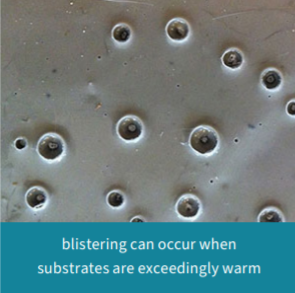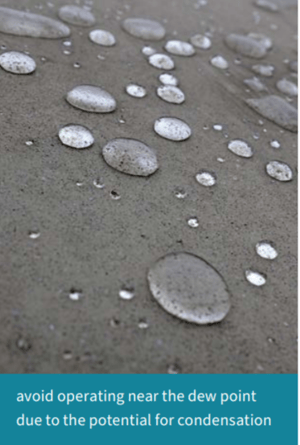Today’s garage flooring installer has all types of options when it comes to finding the best system for their climate(s). Product and system selection plays a key role depending on your geographic location and as the climate changes throughout the seasons.
Product Categories
Epoxies, urethanes and polyaspartics will have different characteristics based on the ambient and substrate temperatures as well as humidity. These variables can have significant impact on material usability and well as long-term performance.
Epoxies
Epoxies tend to cure faster in warmer environments and are best suited for applications with a minimum temperature of 60ºF. For water-based epoxies, 60ºF often represents the bare minimum. Some 100% solid epoxies will cure down to 40 50ºF, especially those epoxies engineered for faster cure schedules.
Urethanes
In general, urethane topcoats require a minimum temperature of 50 degrees in order to properly cure. Urethane Cement materials, often used in kitchens, breweries and food manufacturing also have minimum temps of approximately 50ºF. Applying at temperatures lower than that can significantly extend cure schedules and potentially inhibit performance.
Polyaspartic Coatings
Polyaspartic coatings provide for a greater range of application temperatures and are especially useful in colder environments. Some polyaspartics may be used below freezing. The primary issue with polyaspartics in colder temperatures is maintaining the appropriate material viscosity for application. Storing the material at room temperature prior to application can help maintain a workable viscosity.
Epoxies, urethanes and polyaspartics will have different characteristics based on the ambient and substrate temperatures as well as humidity. These variables can have a significant impact on material usability and well as long-term performance.
Colder Temperatures and Surfaces - Things to Consider
When materials are applied at temperatures below their minimum recommended threshold, they may take far longer to dry and may never cure at all. Some materials may only partially cure, leaving inadequate hardness or chemical resistance. Remember that while a room may be within the recommended temperature threshold, it is the surface temperature of the substrate that is most important. A cold floor can take a long time to heat up. Other areas close to an exterior wall or freezer door may also be problematic as the colder temperatures can transfer through the substrate and extend cure schedules. Ensure that you maintain the correct temperature for the chosen material.
Materials should be brought to room temperature prior to application to minimize any potential issues.
Warmer Temperatures and Surfaces - Things to Consider
 When applying in higher temperatures, most materials will experience a reduced pot-life. For substrates that are extremely hot, the coating may exhibit bubbling or blistering following application. As is the case with colder environments, a concrete floor will retain its heat over time and care needs to be taken to bring it to the appropriate temperature. For warmer applications, it is important to keep the material cool or at room temperature prior to installing. One of the common issues is that material will be left in the back of a trailer on a hot day, or worse in full sun. This elevated material temperature will significantly reduce pot-life and may lead to issues such as bubbling, blistering and lack of adhesion.
When applying in higher temperatures, most materials will experience a reduced pot-life. For substrates that are extremely hot, the coating may exhibit bubbling or blistering following application. As is the case with colder environments, a concrete floor will retain its heat over time and care needs to be taken to bring it to the appropriate temperature. For warmer applications, it is important to keep the material cool or at room temperature prior to installing. One of the common issues is that material will be left in the back of a trailer on a hot day, or worse in full sun. This elevated material temperature will significantly reduce pot-life and may lead to issues such as bubbling, blistering and lack of adhesion.
Humidity Concerns
In addition to temperature, ambient humidity levels within an environment have a significant impact on installation working times, cure schedules and performance. Some materials may even use moisture in the air as a catalyst. avoid operating near the dew point due to the potential for condensation
Respect the Due Point
 For most coatings, manufacturers recommend that the floor coating materials not be applied when the temperature is within 5 degrees of the dew point. This scenario is common if precipitation is in the forecast. High or rising humidity levels can cause condensation (a thin film of moisture) to settle on the surface of the concrete that you more than likely cannot even see. This can result in the coating bubbling due to trapped moisture, orange peel, pin-holing and lack of adhesion.
For most coatings, manufacturers recommend that the floor coating materials not be applied when the temperature is within 5 degrees of the dew point. This scenario is common if precipitation is in the forecast. High or rising humidity levels can cause condensation (a thin film of moisture) to settle on the surface of the concrete that you more than likely cannot even see. This can result in the coating bubbling due to trapped moisture, orange peel, pin-holing and lack of adhesion.
Amine Blush
For epoxy materials, environments with elevated or rising humidity levels may also experience a phenomenon called Amine Blush. This is due to humidity reacting with the resin, often causing a wax-like film and discoloration to the surface.
Amine blush can also be caused by excessive carbon dioxide in the environment. This is often seen when installers use propane tunnel heaters in colder months. The excessive carbon dioxide emitted by these units cause condensation, which leads to amine blush.
Amine blush can be removed with soapy water/rinse or a solvent wipe. If left unattended, it will most certainly cause inter-coat adhesion issues.
Extended Cure Times
Some materials such as water-based epoxies may experience extended dry times in higher humidity situations. Quite simply, these materials contain water that needs to evaporate. If the air is already full of water (high humidity) then the water evaporation rate and associated cure time will be slower when compared to a dry environment.
Reduced Working Times
Other materials such as urethanes and polyaspartics may react with humidity in the air as a curing agent. The net effect of this is that higher humidity will reduce working times and cure schedules. For especially warm and humid climates, this can make some materials challenging to work with and prone to certain issues such as uneven finishes and roller marks.
White or Foggy Finish: For polyaspartic coatings, higher humidity can significantly reduce cure schedules. Often times when these materials are applied too thick, the surface area directly exposed to humidity will skin over prior to the rest of the coating reaching its full cure. This essentially caps the still curing material, trapping gasses within the film and causing it to cloud up. This is especially apparent in corners as well as the base of walls where a vertical cove is applied and material is allowed to build up.
Looking for more quick tips like these? Learn how to:
- Manage climate concerns
- Minimize waste and expense
- Optimize your work environment
In this guide for residential flooring installers. Click the button below to download.


 Previous article
Previous article